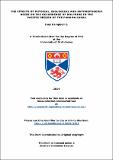Files in this item
The effects of physical, biological and anthropogenic noise on the occurrence of dolphins in the Pacific region of the Panama Canal
Item metadata
| dc.contributor.advisor | Hammond, Philip S. | |
| dc.contributor.author | Campbell Castillo, Inez | |
| dc.coverage.spatial | 276 | en_US |
| dc.date.accessioned | 2014-02-28T14:55:07Z | |
| dc.date.available | 2014-02-28T14:55:07Z | |
| dc.date.issued | 2014-06 | |
| dc.identifier | uk.bl.ethos.595634 | |
| dc.identifier.uri | https://hdl.handle.net/10023/4484 | |
| dc.description.abstract | The main aim of this thesis was to investigate the occurrence of dolphins in Pacific waters adjacent to the Panama Canal in the context of biological, temporal and spatial factors. Acoustic data were collected at 101 sites at a range of distances and depths from the shipping region. Data were collected between March 2010 and April 2011 in a diurnal cycle over a total of 114 recording days. Received sound levels were split into 1/3 Octave bandwidths to study variation in sound pressure levels and then converted to spectrum density levels to show the sound components of the background noise in this region. Generalised Linear Models were used to relate dolphin whistle detections to temporal, spatial, environmental and acoustic variables. The major sources of background noise were biological noise from soniferous fish and snapping shrimp and anthropogenic noise from vessels characterised by mid to high frequencies produced by artisanal fishing boats. There was monthly and diurnal variation with some locations characterised by loud sounds in the mid to high frequencies at night. Whistle characteristics analysis revealed that the frequencies and range of the whistles were different to those previously reported under similar conditions. Whistles varied diurnally and in the presence of fish chorus and fishing boats. The study highlights a strong correlation between fish choruses and whistle detection. Temporal and spatial models showed that whistle detections varied monthly and in relation to fish noise and small vessel engine noise. Dolphins were distributed throughout most of the study area; however, whistle detections varied with distance from the coast. The results provide new knowledge about background noise composition in this region and provide the first information on the ecology of dolphin whistles in relation to this background noise, especially to fish chorus. | en_US |
| dc.language.iso | en | en_US |
| dc.publisher | University of St Andrews | |
| dc.rights | Creative Commons Attribution-NonCommercial-NoDerivatives 4.0 International | |
| dc.rights.uri | http://creativecommons.org/licenses/by-nc-nd/4.0/ | |
| dc.subject | Dolphins | en_US |
| dc.subject | Background noise | en_US |
| dc.subject | Soniferous fish | en_US |
| dc.subject | Dolphin whistles | en_US |
| dc.subject | Anthropogenic noise | en_US |
| dc.subject | Fish chorus | en_US |
| dc.subject | Panama Canal | en_US |
| dc.subject | Temporal models | en_US |
| dc.subject | Spatial models | en_US |
| dc.subject | Occurrence | en_US |
| dc.subject.lcc | QL737.C432C2 | |
| dc.subject.lcsh | Dolphins--Effect of sound on--Panama Canal (Panama) | en_US |
| dc.subject.lcsh | Dolphins--Panama Canal (Panama)--Ecology | en_US |
| dc.subject.lcsh | Underwater acoustics--Panama Canal (Panama)--Measurement--Data processing | en_US |
| dc.subject.lcsh | Dolphin sounds--Panama Canal (Panama)--Measurement--Data processing | en_US |
| dc.title | The effects of physical, biological and anthropogenic noise on the occurrence of dolphins in the Pacific region of the Panama Canal | en_US |
| dc.type | Thesis | en_US |
| dc.contributor.sponsor | SENACYT/IFARHU | en_US |
| dc.contributor.sponsor | Rufford Foundation | en_US |
| dc.contributor.sponsor | University of St Andrews. Scottish Oceans Institute | en_US |
| dc.type.qualificationlevel | Doctoral | en_US |
| dc.type.qualificationname | PhD Doctor of Philosophy | en_US |
| dc.publisher.institution | The University of St Andrews | en_US |
| dc.publisher.department | Sea Mammal Research Unit | en_US |
This item appears in the following Collection(s)
Except where otherwise noted within the work, this item's licence for re-use is described as Creative Commons Attribution-NonCommercial-NoDerivatives 4.0 International
Items in the St Andrews Research Repository are protected by copyright, with all rights reserved, unless otherwise indicated.


